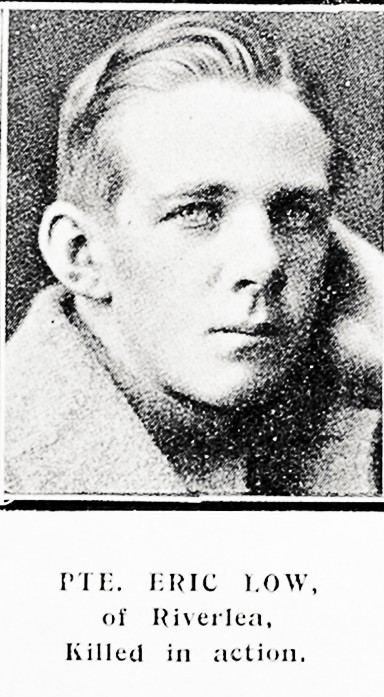Pte
Eric Leslie Low
Informations sur naissance
|
Date de naissance: 31/05/1896 |
|
Lieu de naissance: Palmerston North, Manawatū-Whanganui, North Island, New Zealand |
Informations générales
|
Profession: Agriculteur |
Informations service militaire
|
Pays: New Zealand |
|
Force armée: New Zealand Expeditionary Force |
|
Rang: Private |
|
Numéro de service: 47905 |
|
Incorporation date: 23/01/1917 |
|
Incorporation nom de lieu: Hawera, Taranaki, New Zealand |
|
Unités: — Otago Regiment, 1st Bn. |
Informations sur décès
|
Date de décès: 03/12/1917 |
|
Lieu de décès: Polderhoek Château, Belgique |
|
Cause du décès: Killed in action (K.I.A.) |
|
Âge: 21 |
Cimetière
|
Buttes New British Cemetery, Polygon Wood Parcelle: I Rangée: D Tombe: 3 |
Distinctions et médailles 2
|
British War Medal Médaille |
|
Victory Medal Médaille |
Points d'intérêt 2
| #1 | Lieu de naissance | ||
| #2 | Lieu d'enrôlement |
Mon histoire
Eric Low was born in Palmerston North, New Zealand on 31 May 1896. His parents were David Walker Low, a schoolmaster, and Mary Jane Collingwood. He was one of six children.
Eric was a farmer in Taranaki Province when he enlisted at Hawera on 23 January 1917, joining the 26th Reinforcement, service number 47905. He trained for infantry service at Trentham and Featherston camps before he embarked from Wellington on 9 June 1917 on the troopship Willochra.
After arriving in England on 16 August, he spent five weeks training at Sling Camp before posting overseas to the Western Front. He joined the 8th Company, 1st Otago Battalion on 24 October 1917, a few weeks after the First Battle of Passchendaele.
The New Zealand Division was in the Polygon Wood area, after the end of the Third Battle of Ypres. Much of the time was spent in wiring, repairing crumbling trenches and improving defences. The landscape was covered with waterlogged shellholes. The right of the New Zealand position was enfiladed from Polderhoek and a decision was made to capture the spur on which the ruins of Polderhoek Chateau and German pillboxes sat.
1st Otago and 1st Canterbury battalions of the 2nd Brigade were selected to make the attack on 3 December 1917. 1st Otago attacked on the left of the start line, towards the chateau itself. In spite of artillery preparation, German fire from the chateau area and from both flanks proved too strong. A small area overlooking the Sherriabeek was captured but the main objective remained in German hands.
1st Otago Battalion lost 45 killed, 26 missing and 160 wounded in this action. Eric Low was among the casualties on 3 December 1917. It is likely he was killed by machine gun or rifle fire. His body was recovered, identified by disc and badge, and buried nearby. He is now buried in Buttes New British Cemetery at Polygon Wood, in Plot I, Row D, Grave 3.
Eric was a farmer in Taranaki Province when he enlisted at Hawera on 23 January 1917, joining the 26th Reinforcement, service number 47905. He trained for infantry service at Trentham and Featherston camps before he embarked from Wellington on 9 June 1917 on the troopship Willochra.
After arriving in England on 16 August, he spent five weeks training at Sling Camp before posting overseas to the Western Front. He joined the 8th Company, 1st Otago Battalion on 24 October 1917, a few weeks after the First Battle of Passchendaele.
The New Zealand Division was in the Polygon Wood area, after the end of the Third Battle of Ypres. Much of the time was spent in wiring, repairing crumbling trenches and improving defences. The landscape was covered with waterlogged shellholes. The right of the New Zealand position was enfiladed from Polderhoek and a decision was made to capture the spur on which the ruins of Polderhoek Chateau and German pillboxes sat.
1st Otago and 1st Canterbury battalions of the 2nd Brigade were selected to make the attack on 3 December 1917. 1st Otago attacked on the left of the start line, towards the chateau itself. In spite of artillery preparation, German fire from the chateau area and from both flanks proved too strong. A small area overlooking the Sherriabeek was captured but the main objective remained in German hands.
1st Otago Battalion lost 45 killed, 26 missing and 160 wounded in this action. Eric Low was among the casualties on 3 December 1917. It is likely he was killed by machine gun or rifle fire. His body was recovered, identified by disc and badge, and buried nearby. He is now buried in Buttes New British Cemetery at Polygon Wood, in Plot I, Row D, Grave 3.
Sources 2
|
Births deaths marriages New Zealand https://www.bdmhistoricalrecords.dia.govt.nz/ Sources utilisées |
|
Stewart H., The New Zealand Division 1916-1919 : a popular history based on official records, (Auckland, Whitcombe & Tombs Ltd, 1921), pg. 304-313. Sources utilisées |
Complément d’informations 5
|
Commonwealth War Graves Commission Database https://www.cwgc.org/find-records/find-war-dead/casualty-details/480341 |
|
Namenlijst (In Flanders Fields Museum) https://namenlijst.org/publicsearch/#/person/_id=c9e0ed0c-e64e-4127-be33-bac3323fe4e9 |
|
Lives of the First World War (Imperial War Museum) https://livesofthefirstworldwar.iwm.org.uk/lifestory/7178328 |
|
The NZEF Project (UNSW Canberra) https://nzef.adfa.edu.au/showPerson?pid=151062 |
|
Online Cenotaph (Auckland Museum) https://www.aucklandmuseum.com/war-memorial/online-cenotaph/record/c8955 |
